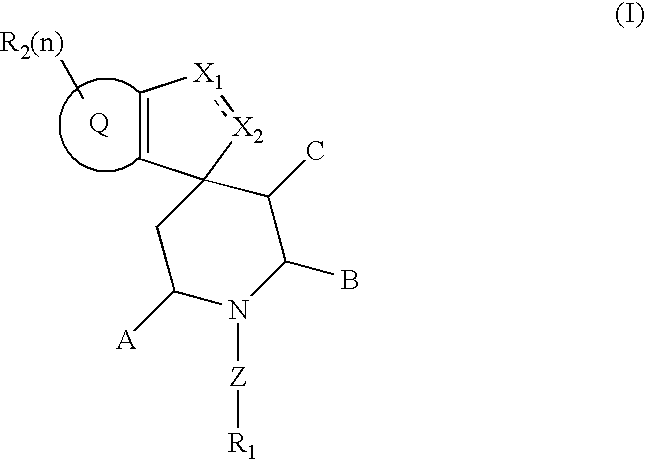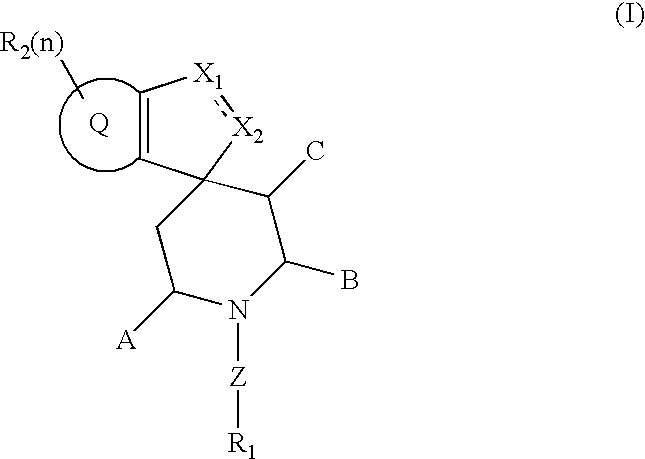Spiroindene and spiroindane compounds
a technology which is applied in the field of spiroindene and spiroindane compounds, can solve the problems of untold amount of suffering, and achieve the effect of sufficient time for metabolism
- Summary
- Abstract
- Description
- Claims
- Application Information
AI Technical Summary
Benefits of technology
Problems solved by technology
Method used
Image
Examples
example 2
[0169] 10
[0170] Procedure:
[0171] Compound 1 (3.0 g, 9.9 mmol) was hydrogenated in a Parr apparatus in 30 mL of acetic acid with 3.5 g of 5% Rh on alumina catalyst at an initial pressure of 18 psi. The theoretical amount of hydrogen was taken up over three days and the reaction mixture was filtered to remove the catalyst. The acetic acid was evaporated at 35.degree. under aspirator pressure. The residue was taken up in hexane and washed with sodium bicarbonate solution and then water. Evaporation of the hexane afforded 4 as a cream colored solid (2.5 g, 83%).
[0172] .sup.1H-NMR (CDCl.sub.3): d 1.00-1.78 (m, 26H), 2.33 (b, 1H), 3.05-3.30 (m, 2H), 3.53 (m, 2H).
[0173] To an ice cooled solution of compound 4 (1.00 g, 3.38 mmol) in 20 mL of CH.sub.2Cl.sub.2 was added 3 mL of TFA and the reaction mixture stirred at room temperature overnight. The solvent was evaporated and the residue dissolved in CHCl.sub.3, washed with 2N NaOH, dried over K.sub.2CO.sub.3, filtered, and concentrated. The c...
example 3
Attachment of Tail Groups
[0175] Tail groups were attached to the indene and indane head groups according to the following procedures: 11
[0176] General Procedure for Alkylation:
[0177] To a solution of the amine (1 eq) and triethylamine (1 eq) in dimethylformamide, was added 1 eq of alkyl bromide or chloride in one portion. The mixture was stirred and heated at 80.degree. C. over night. TLC indicated the reaction was complete. The reaction was quenched by the addition of water followed by 1 N NaOH to pH 10. The mixture was extracted 2.times. with Et.sub.2O. The combined organic extracts were dried over potassium carbonate and the solvent evaporated, followed by chromatography to give the pure product.
[0178] General Procedure for Reductive Amination:
[0179] To a mixture of ketone or aldehyde (1 eq), amine (1 eq), and acetic acid (1 eq) in methanol, was added sodium cyanoborohydride (1.4 eq) in one portion. The mixture was stirred over night at room temperature. TLC indicated the reactio...
example 4
[0283] 12
[0284] Procedure:
[0285] Compounds 6 and 9 were prepared as described in U.S. Pat. No. 5,578,593.
[0286] To a solution of compound 6 (1.30 g, 4.29 mmol) in 25 mL of CH.sub.2Cl.sub.2 was added 1 mL of TFA and stirred at room temperature for 14 hr. The solvent was evaporated and the residue dissolved in CHCl.sub.3, washed with 2N NaOH, dried over K.sub.2CO.sub.3, filtered, and concentrated. The crude product was purified by column chromatography over silica gel (CHCl.sub.3:MeOH:NH.sub.3 4:1:0.1) to give the amino alcohol as a viscous oil (0.11 g, 13%). To a solution of this compound in 10 mL of THF was added Et.sub.3N (0.5 mL) and 2-(bromomethyl)naphthalene (0.14 g, 0.63 mmol). The reaction mixture was stirred at room temperature for 14 hr, filtered and the white solid washed with THF. The filtrate was evaporated and the residual oil purified by column chromatography (CHCl.sub.3:MeOH 9:1) to give compound 7 as a viscous oil (0.10 g, 53%).
[0287] .sup.1H-NMR (CDCl.sub.3): d 1.40 ...
PUM
| Property | Measurement | Unit |
|---|---|---|
| pressure | aaaaa | aaaaa |
| pH | aaaaa | aaaaa |
| pH | aaaaa | aaaaa |
Abstract
Description
Claims
Application Information
 Login to View More
Login to View More - R&D
- Intellectual Property
- Life Sciences
- Materials
- Tech Scout
- Unparalleled Data Quality
- Higher Quality Content
- 60% Fewer Hallucinations
Browse by: Latest US Patents, China's latest patents, Technical Efficacy Thesaurus, Application Domain, Technology Topic, Popular Technical Reports.
© 2025 PatSnap. All rights reserved.Legal|Privacy policy|Modern Slavery Act Transparency Statement|Sitemap|About US| Contact US: help@patsnap.com



